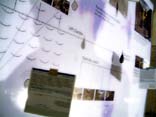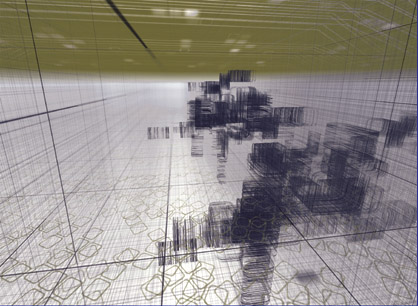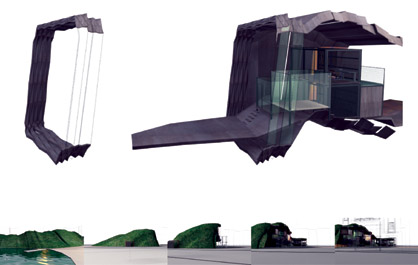|
|
||||||
| image | activities | contacts | links | italiano | ||||||
|
|
||||||
|
introduction |
The Auckland School of Architecture has a long tradition of excellence
in design representation and communication using traditional media.
This emphasis on the close relationship between media and the development
of design concepts has been extended in recent years to exploit the
possibilities of digital technologies. The transfer of the computer
from sterile laboratory to design studio has allowed students and tutors
to work between screen, drawings and physical models in the fertile
setting of large open plan studios, with the more computer intensive
courses been offered over the summer recess as digital design summer
schools. 'Digital Summer' is a selection of student projects from these
studios that utilise state of the art software to push the boundaries
of representation and communication. While there are a range of themes
explored the works are less concerned with the use of digital graphics
and audio as a construction simulation tool but following on from the
tradition of "paper architecture" the intent here is to use digital
technology as an immersive environment for the fluid exploration of
time based form, space and audio from which architecture may eventually
be actualised. Jules Moloney, Director Digital Design Program |
 Installation at the Stazione Leopolda, Florence (photo by: Omar Cotza) |
||||
| Architectural
games 03: edge conditions between digital shadow and analogue event Instructor: Jules Moloney |
||||||

Architectural Games 03. Project by Sangsoo Kim Media: This digital summer design studio undertaken at the University of Auckland in January 2003 is the third of a series in which computer game engines are appropriated as digital design media. The design media utilised is StringCVE, a software application developed by the School of Architecture that adds design critique functionality to the torque multiplayer game engine. An overview of the system set up and communication modules is illustrated below. Studio Theme: Simultaneous with physical events that take place at retail checkout, sports arena or the international stages of commerce and conflict is the digital "shadow" of the actual that is transmitted via data networks as codified text, speech and image. The edge condition between this digital shadow and actuality is increasingly blurred both in terms of cause/effect –an inverse argument can be posited that physical outcomes are increasingly the shadow of digital events (international finance for example)– and blurred by the proliferation of digital devices that augment our physical existence. The studio speculated on this edge condition in order to consider what paradigms are advantageous to the spatial design of information, and to propose designs for the physical interface to this information at the individual, architectural and urban scale. The site was an industrial area next to the America’s cup base on the Auckland harbour front. Students worked in the StringCVE environment from the onset and met and discussed their ideas "in game" or left comments using the asynchronous critique module. From these individual positions group projects evolved and were developed into hybrid schemes that can be interpreted as both architectural form and information space. The final projects then utilised the communication module to annotate the work–navigation of the real time graphics and audio can occur by clicking on teleport links in the virtual environment or by browsing the annotations from the php text forum. |
Jules Moloney is a senior Lecturer at the School of Architecture at the University of Auckland. His current research focus is the use of computer game engines to enable collaborative virtual environments for architectural design. | |||||
| Global
Technology / Local Light Instructor: Judy Cockeram |
||||||

Global Technology / Local Light. Project by Phillip Kwong These works utilise global technology to explore local conditions: the digital allowing the visceral back into the documentation of the Architect by the use of e-light, e-material, e-sound and e-motion to explore local conditions and a strong indigenous cultural context. In the work of the students exhibited here we can see evidence of the care taken in showing architecture that includes the cultures of New Zealand. Nick Dalton and David Edwards give us a Library on the shores of Lake Rotoura that pushes the realms of the possible and questions the nature of knowledge in a predominantly Maori environment. Phillp Kwong presents a film that contains motion that reinforces the cut up nature of the building. In both these works the qualities are held still in these chosen and choice moments. The motion of the camera is used to tell and add to the stories of the buildings. Mel Tokins' work lets us question the nature of perception. What is real or captured is used to test and question the nature of time and Architecture in multiple sites. It is again only in the motion of the films that we see the tiny changes brought to Architecture itself by its own existence in the portages of Auckland. |
Judy Cockeram is a senior design tutor at the School of Architecture, University of Auckland, New Zealand. Current research interests are the observation of the electronic as it covers the theoretical issues of light, surface, women and the crafted object or space of architecture. | |||||
| site
hosted by ARCH'IT rivista digitale di architettura www.architettura.it |
||||||
